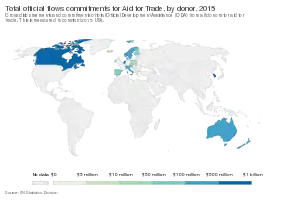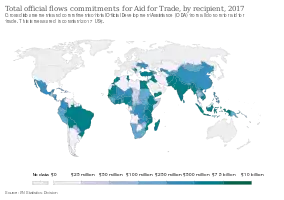Aid for Trade
Aid for Trade is an initiative by the World Trade Organization (WTO), as well as a policy concept in international economic and trade development, concerned with helping developing countries and particularly the least developed countries build trade capacity and infrastructure.[1][2][3]
.jpg.webp)
Aid for Trade is included in Sustainable Development Goal 8 concerning "decent work and economic growth", which is one of the 17 Sustainable Development Goals which were established by the United Nations General Assembly in 2015. Target 8.a aims to "Increase Aid for Trade support for developing countries, in particular, least developed countries, including through the Enhanced Integrated Framework for Trade-related Technical Assistance to Least Developed Countries."[4]
In 2018, aid for trade commitments remained stable, at $58 billion, based on current prices.[5] South and Central Asia received the highest share thereof (31.4 per cent), followed by sub-Saharan Africa (29.2 per cent).[5] Lower-middle-income countries received 37.5 per cent of aid for trade, followed by least developed countries (36.8 per cent).[5]
Overview
.jpg.webp)
Aid for Trade includes measures to help countries develop trade strategies, plans or projects and implementation, such as building roads, ports, and telecommunications that link domestic and global markets, or investing in industries and sectors to help diversify exports.[6][7]
Many have credited Aid for Trade with economic improvements in developing countries,[8][9] while others point out that not all trade initiatives are successful and some of the funding is lost to corruption.[10]
The OECD and WTO established an 'aid-for-trade monitoring framework' to track progress in implementing the Aid-for-Trade Initiative. It consists of the following elements:[2]
Value of commitments


According to the UN, in 2017, the global total value of Aid for Trade disbursements exceeded USD 43 billion, with an additional c. USD 15 billion committed.[3] Increasing Aid for Trade support is included as an objective in the United Nations Sustainable development growth 8 "decent work and economic growth" indicator 8.a.[11]
The EU and its member states are the largest contributor of Aid for Trade.[12]
In 2018, aid for trade commitments remained stable, at $58 billion, based on current prices.[5] South and Central Asia received the highest share thereof (31.4 per cent), followed by sub-Saharan Africa (29.2 per cent).[5] Lower-middle-income countries received 37.5 per cent of aid for trade, followed by least developed countries (36.8 per cent).[5]
Origins and oversight
The Aid for Trade initiative was launched at the World Trade Organization Ministerial Conference in December 2005,[13][2] and in 2007, the WTO started implementation of its February 2006 recommendations of the Aid for Trade Task Force as it moved into its first stage.
The purpose of the Global Review is to provide strong monitoring and evaluation for the Aid for Trade agenda. Global Review events have been held under the themes of “Maintaining Momentum”, “Showing Results”, and “Connecting to Value Chains” in 2009, 2011 and 2013 respectively.
- First Global Review 2007
- Second Global Review 2009
- Third Global Review 2011
- Fourth Global Review 2013
- Fifth Global Review 2015
- Sixth Global Review 2017
- Seventh Global Review 2019
Sustainable development
Aid for Trade is included in the Sustainable Development Goal 8 about "decent work and economic growth" which is one of the 17 Sustainable Development Goals which were established by the United Nations General Assembly in 2015. The official wording for Target 8.a is to "Increase Aid for Trade support for developing countries, in particular, least developed countries, including through the Enhanced Integrated Framework for Trade-related Technical Assistance to Least Developed Countries."[4]
This target has one indicator. Indicator 8.a.1 is the "Aid for Trade commitments and disbursements".
The indicator 8.a.1 is measured as total Official Development Assistance (ODA) allocated to aid for trade in 2015 US$.
References
- "WTO | Development - Aid for Trade fact sheet". www.wto.org. Retrieved 2020-09-21.
- "Aid for Trade". OECD.org. Retrieved 22 September 2020.
- "Aid for Trade". UN.org. Retrieved 22 September 2020.
- United Nations (2017) Resolution adopted by the General Assembly on 6 July 2017, Work of the Statistical Commission pertaining to the 2030 Agenda for Sustainable Development (A/RES/71/313)
- United Nations (2020). "United Nations World Economic Situation and Prospects". undocs.org. Retrieved 2020-09-02.
- "WTO | Aid for Trade - gateway". www.wto.org. Retrieved 2020-09-21.
- "Aid for Trade". USTR.gov. Retrieved 22 September 2020.
- Adhikari, Radhakar (26 September 2019). "Targeting Aid for Trade for Impactful Capacity‐Building in the Least Developed Countries". Global Policy. 10 (3): 408–412. Retrieved 22 September 2020.
- Hussain, Zaidi (8 April 2019). "Aid for trade, and not merely trade, is what country needs". Express Tribune. Retrieved 22 September 2020.
- "Aid for trade – reducing the barriers and increasing the benefits". The Guardian. 21 August 2013. Retrieved 22 September 2020.
- "8.a increase Aid for Trade support for developing countries, particularly LDCs, including through the Enhanced Integrated Framework for LDCs – Indicators and a Monitoring Framework". indicators.report. Retrieved 2020-09-23.
- "Aid for Trade: Helping developing countries to achieve prosperity through trade and investment". European Commission. Retrieved 22 September 2020.
- "WTO | Ministerial conferences - Hong Kong 6th Ministerial". www.wto.org. Retrieved 2020-09-21.
